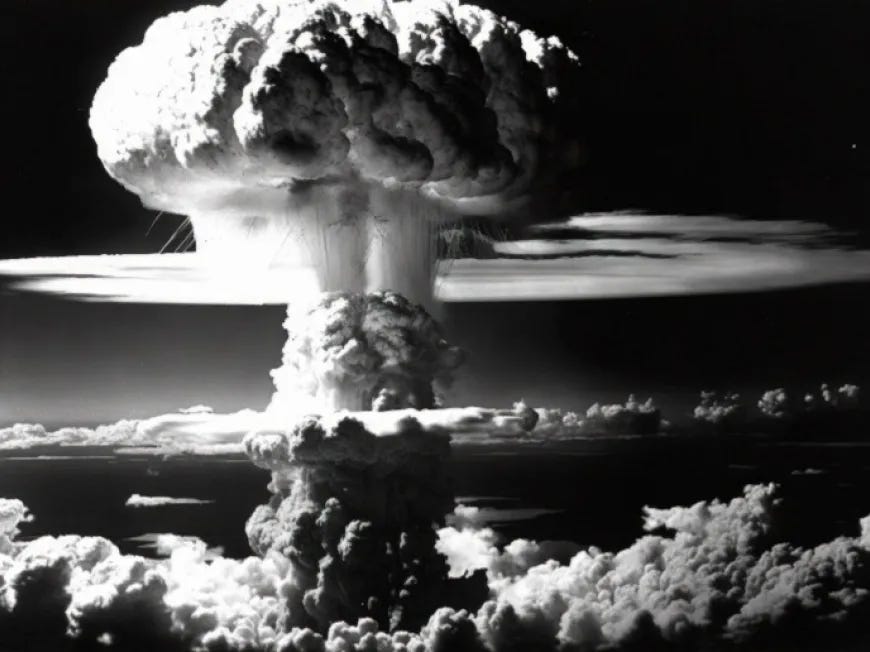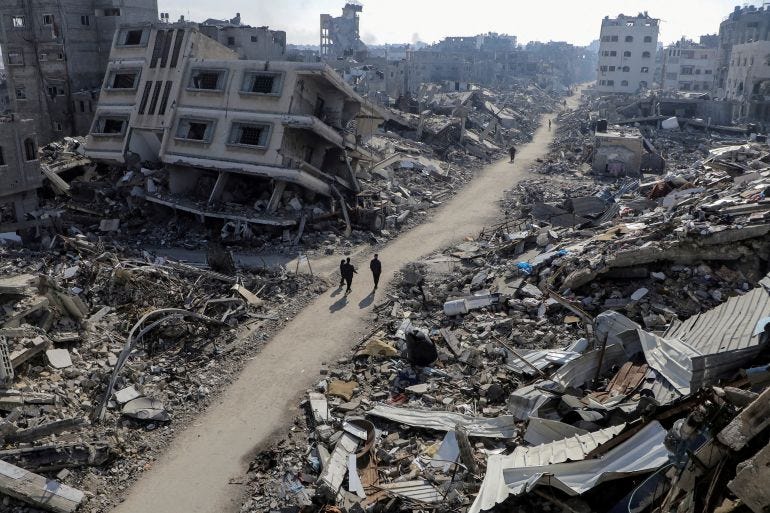Tactical nukes are still nukes
If you think that tactical nuclear weapons can be "safer" and "less harmful" than their strategic counterparts, better think twice.
Recent developments in the war in Ukraine — in particular, the announcement of tactical nuclear drills by the Russian Federation — have brought us once again closer to the brink. Just a bit closer, but very dangerous nonetheless.
The announcement came in the aftermath of statements by British Foreign Secretary David Cameron and French President Emmanuel Macron. In an interview with The Economist, Macron said that he would “not rule out” the deployment of troops to Ukraine, in case the situation became desperate (even more than it is now).
And Cameron, not to be outdone, said the UK (unlike the United States and other NATO countries) would not impose any condition on Ukrainian use of British missiles — including striking targets inside Russian territory.
Moscow’s reaction didn’t take long, and the British and French Ambassadors received a stern dressing-down. The Kremlin considers that the use of British missiles to strike Russia, with the approval of the UK government, amounts to the direct participation of that country in the conflict — in other words, an act of war. Russia would respond accordingly, striking “any British military facilities and equipment on the territory of Ukraine and abroad” (“abroad” is the operative word here).
Situation normal, all not f*cked up (yet)
Russian officials claimed that the military training exercises aim to “maintain troop combat posture”, besides being a response to Cameron and Macron’s statements. Their main purpose is to “cool heads” through a “scare effect”.
The plan seems to have worked, at least with Macron. He immediately backed down from his more belligerent remarks, denying that there are any French troops in Ukraine, and being adamant that his country is not at war with Russia. But this may just have been the latest round in his policy of “strategic ambiguity”, so it is likely he will zigzag to a more warlike stance later.
As for the British, at the time of this writing, not only was there no formal response from the government, but they decided to escalate — expelling a Russian defence attaché, accused of being an intelligence officer in disguise, and bragging about this “unequivocal message”. The Russian government has already announced that an “appropriate response” is in the works.
The British attitude is very concerning, but not surprising. Many members of the country’s establishment, and indeed many British citizens, still harbour the illusion that the UK is a global power.
According to German geopolitical analyst Tarik Cyril Amar, the Russians are not messing around when it comes to nuclear weapons. So much so that many European countries were quick to distance themselves from France’s and the UK’s reckless posturing.
Amar does a great job dissecting the Russian nuclear doctrine. It deserves listening in full. One particular point is extremely relevant.
“What I … find astonishing, frankly, is that … these Russian warnings about tactical or battlefield or small nuclear weapons are understood as if they automatically implied that even if Russia were to use such a weapon, it would ‘only’ use it on the territory of Ukraine. In fact, Russian military doctrine says the exact opposite … In February this year, Putin has given a speech to the Federal Chamber [and] at one point, he essentially addressed not that assembly, but the West. And what he says very, very clearly is, if you continue messing with us in Ukraine, please understand we have weapons that can reach you in your own countries.”
He urges the Western powers to sit down and listen.
“Russia is sending us an extremely important, if very rough, signal. And I hope that media persons, politicians, planners, so-called military experts, many of whom have certainly not had a glorious record in this war and over the time of this war, finally absorb this one big lesson, which is the Russians actually sometimes mean it. And especially when they're telling you these concerns are vital interests.”
Western politicians and corporate media learning a lesson? Fat chance.
Knowing what tactical nuclear weapons are, and how they differ from the ones we are “used to” (sort of), will help offer some context for these developments.
There’s no precise definition of a tactical nuclear weapon (TNW), so a good start is to know what they’re not. And, as Captain Obvious would say, they are not strategic nuclear weapons (SNWs). An SNW is basically a weapon for genocide: to devastate a very large area, like cities, industrial, energy, economic, and military infrastructure, and so on, far from the battlefield. The idea is to destroy as much as possible, and kill (directly or slowly through radiation) as many people as possible.
Target Europe
TNWs, on the other hand (according to standard views), are meant to be used on the battlefield or against military facilities; have a short range when launched (at most around 500 km); can be relatively small and portable; and usually (but not necessarily) have a lower “yield” than the Big Ones. “Yield” is the destructive power, measured in tons of TNT. To give an example, the bomb dropped on Hiroshima had around 15 kilotons (equivalent to 15,000 tons of TNT) — plus radiation, of course. The most destructive weapons are the SNWs that can pack more than 1 megaton (a million tons of TNT).
But this talk of lower yields can be a bit misleading, because TNWs can go from a few hundred tons to way more than 100 kilotons. This means that a Hiroshima-like bomb is far from being the most destructive tactical weapon. It was used strategically in 1945 — the goal was to exterminate tens of thousands of people in an instant — but today it could very well be used to destroy a large concentration of enemy troops in a battlefield.
It is estimated that today the United States has around 200 TNWs, roughly half of them in Europe, deployed in Italy, Germany, Turkey, Belgium, and the Netherlands. The B61 bombs, launched from aeroplanes, are “dial-a-yield” bombs, because they can be calibrated from 300 tons to 170 kilotons (and are in the process of being upgraded). Russia, on the other hand, is believed to have almost ten times as much, close to 2,000, that could be dropped from planes or launched from ships or mobile ground devices.
London calling, nobody answers
I will stick with the example of Hiroshima because of its cultural and political resonance. It became engraved in our collective memory as the icon of nuclear Armageddon. So let’s imagine an Hiroshima-like TNW dropped over Westminster, in London, and detonated 600 metres above ground. A simulation using the site NukeMap estimates that more than 75,000 people would die, with close to 250,000 injured. The smallest yellow circle below represents the area of the fireball. The Houses of Parliament and everybody in the vicinity are immediately vaporised.
Buildings inside the small red circle (diameter of 680m) are demolished or severely damaged, and almost everybody dies. Radiation inside the green zone kills more than half of the people there in at most one month, with 15% of the survivors developing cancer afterwards. Beyond that, in Soho, Covent Garden, Piccadilly Circus, and parts of the South Bank, air pressure is so high that most residential buildings risk collapsing and huge fires may spread in commercial areas — with death and injuries everywhere. Almost all survivors suffer third-degree burns that, in many cases, will require amputation.
Finally, the zone nearer to the outermost white circle suffers less severe damages, but even then, many people can get seriously injured when all glass windows break, not to mention the risk of blindness caused by the flash of the explosion. And all this happens in an area of approximately 65 km2.
Hiroshima in your backyard
What if a Hiroshima-like weapon, in a missile warhead, explodes on the ground? This would be a more likely use for a TNW, since the target would be very focused and, so it is believed, there would be much fewer casualties — “only” 30,000 dead and 100,000 injured in our example. However, surface blasts generate radioactive fallout that can travel a long way. In this case, with a wind of just 25 km/h, it would reach more than 100 km. A nightmare.
The British government is surely aware of this. Have the Western elites simply forgotten how the game works? The Cold War taught us that you should never engage in direct conflict with a nuclear superpower. It took Kennedy and Khrushchev to stare down the abyss to realise that. This is why all confrontations between major powers have been proxy wars ever since.
But in a time where “negotiation” is a dirty word, and hubristic, delusional thinking has taken over so many so-called leaders, we’re all in for a rough ride.
No need to go nuclear to be disastrous
But it’s no consolation to think that a less destructive bomb, like the 300-ton version of the B61, would be OK to use. It would still cause much more damage than a conventional weapon. And for a non-nuclear explosion equivalent to around 300 tons of TNT, we have a real example. The Beirut blast in 2020 flattened a large area in the city’s port, killing 218 people and injuring 7,000. The impact was felt as far as Cyprus.
An even more horrific example is the genocide unfolding right before our eyes in Gaza. In less than one month (November last year), Israel had already pounded the defenceless civilian population with the equivalent of two nuclear bombs roughly the size of those dropped on Japan.
Just look at the pictures of the devastation and imagine that amount of explosives being delivered by evasive hypersonic missiles, which can avoid air defences, travelling at least five times faster than the speed of sound.
As far as we know, Russia, China, and, allegedly, North Korea are the only countries that possess that technology. And why? Because the West simply gave up on building real stuff (and having the skills to do it). It’s the price you pay for being a “post-industrial” society.
America First
As in almost all things nuclear, the United States went there first. It started in the 50s with very low-yield TNWs. But the idea of using bigger-yield weapons on battlefields started to be viewed as an option.
China was a potential target during a crisis in Taiwan in 1958. And of course there was Vietnam, where General Curtis LeMay, together with other high-ranking officers, forcefully argued for their use. After 9/11, there was some speculation about their possible use in Afghanistan, but thankfully it didn’t happen.
The treaties signed between the United States and Russia after the end of the Cold War didn’t cover TNWs, but the two countries nevertheless drastically reduced their arsenals. The US decided that it wasn’t worth it to invest too much in TNWs. Conventional weapons could do “well” enough without the risks of escalation.
So what’s the point?
There are good reasons why TNWs were never used. As we have seen, it’s not just a matter of destructive power — there are many more factors to consider, especially the spread of radiation.
The main problem, though, is the unpredictability that the use of TNWs introduces in a war. With strategic, long-range nukes, you can pretty much guarantee mutually assured destruction, or MAD. This doctrine helped prevent a nuclear holocaust during the Cold War (though pure dumb luck was the main factor). The problem now is: you never know how your opponent will respond. Will they decide to deescalate? Call for negotiations? Or — what seems more probable — retaliate with “small” nukes in battlefields, ammo depots, or even military headquarters? How long will it take to a full-on global thermonuclear war?
Probably not too long. But the alternative would also be catastrophic. As Tarik Amar reminds us in his analysis, a “limited” conflict would lead to a normalisation of nuclear war — just like what’s happening in Gaza is already the normalisation of genocide.
Meet the new normal, definitely not the same as the old normal.
Check this out:
The B61 bombs and their deployment in Europe.
On the history of American tactical nukes.
The Nuclear Threat Initiative’s account of TNW.
A profile of Alex Wallerstein, the historian who developed the website NukeMap.

















The French really need a new Revolution before Macron gets Paris nuked. Time to resurrect Madame Guillotine.
Here is a related take:
«Western Leaders Suddenly Remember Putin Is, In Fact, President of Russia, Following Minor Nuclear Scare»,
https://complexiathesinker.substack.com/p/western-leaders-suddenly-remember